In the web world the, according to Alexa, the big three in traffic are Yahoo, Google, and Microsoft’s MSN portal. A lot of this volume comes from search as the same three are the most popular search engines although the order in search is Google, Yahoo and MSN.
These three sites are the kings of the Internet at the moment. They all have tons of money to spend on R&D and market research. And they need to spend it so that they can hop on the next big thing quickly enough to at least maintain their position. I believe that mobile data, especially the mobile web is going to be one of those next big things so I thought it would be interesting to see what the big three have been up to in mobile.
Yahoo has had a mobile presence since 1999. At first the service was aimed at PDA’s. But by early 2000 Yahoo had a WAP site which not only had news, sports and finance sections, weather, White and Yellow Pages search, driving directions, and also allowed users access to their mail accounts, calendar, address book, Yahoo messenger and Yahoo auctions. 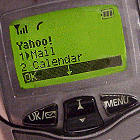 Yahoo already had the ability to sync your Yahoo calendar and address book with Outlook, Notes, ACT or Palm Desktop. This meant that with WAP your phone could give you access to your business appointments and contacts. Simultaneously with the WAP portal launch, Yahoo released Mobile Alerts, a rules based engine that would send a text message to your phone when an email arrived, a meeting was starting soon or a stock price passed a trigger amount. This combination of integrated was very advanced stuff for it’s time. 1999 and 2000 were the heady days of early WAP enthusiasm. However, user acceptance of WAP failed to meet expectations as the high data costs, slow response and limited content of early WAP did not live up to the initial hype. Nonetheless, Yahoo continued to maintain and support their WAP services but did not make any major enhancements for four years.
Yahoo already had the ability to sync your Yahoo calendar and address book with Outlook, Notes, ACT or Palm Desktop. This meant that with WAP your phone could give you access to your business appointments and contacts. Simultaneously with the WAP portal launch, Yahoo released Mobile Alerts, a rules based engine that would send a text message to your phone when an email arrived, a meeting was starting soon or a stock price passed a trigger amount. This combination of integrated was very advanced stuff for it’s time. 1999 and 2000 were the heady days of early WAP enthusiasm. However, user acceptance of WAP failed to meet expectations as the high data costs, slow response and limited content of early WAP did not live up to the initial hype. Nonetheless, Yahoo continued to maintain and support their WAP services but did not make any major enhancements for four years.
That all changed in 2004, Yahoo, apparently sensing that mobile was about to take off began releasing new mobile projects one after another. 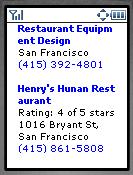 Yahoo Photos, which enabled users to view, print and share camera phone photos uploaded by MMS or email came out in June, 2004. Late in 2004, Yahoo released a completely redesigned mobile portal. The new site was WAP2, although the original WAP1 version is still available and works as well as ever. The new portal features all the content of the WAP1 version enhanced with small photos accompanying some of the news stories plus two new features Yahoo Mobile Search and a RSS reader.
Yahoo Photos, which enabled users to view, print and share camera phone photos uploaded by MMS or email came out in June, 2004. Late in 2004, Yahoo released a completely redesigned mobile portal. The new site was WAP2, although the original WAP1 version is still available and works as well as ever. The new portal features all the content of the WAP1 version enhanced with small photos accompanying some of the news stories plus two new features Yahoo Mobile Search and a RSS reader.
Mobile search is hot right and Yahoo obviously wants to be a player. Yahoo’s version of search for mobile has three components, Local, Images and Web. Local search is a little strange. It’s as if it were based on the Business White Pages and returns listings that contain the search string in their name. Thus a search for “restaurants” will only find those establishments with “restaurant(s)” in their names. This means that it’s really only practical to search by an establishment’s name. Once you have found what you are looking for, Yahoo displays your destination on an appropriately small (128 x 128px) map and provides driving directions to it. Image search retrieves thumbnail images from Yahoo’s huge database of the images it finds spidering the web. 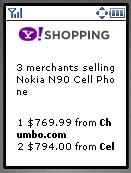

Web search only seems to appear when the browser is on a large screen device like a Treo. It is just Yahoo’s desktop Web Search with only the result listings reformatted for the small screen. Selecting a search hit takes you right to the site with no transcoding – which is probably why that option doesn’t appear on the Yahoo menu when you connect with a mainstream phone like the ROKR or Nokia 6101.
I mentioned Yahoo’s mobile RSS reader last week in my piece comparing mobile RSS, in summary it was an also ran in this category. It makes the feeds you have subscribed to on your desktop at my.yahoo.comm available on your mobile, sort of. All Yahoo shows you on the mobile is a long scrolling list of the titles and descriptions of the items in a feed. It takes a lot of scrolling to see all the items and there is no way to go to the full item content.
In July, 2005 Yahoo launched an SMS search. You text it a search string and it sends back the results in another SMS.
Finally, Yahoo has a public beta of Yahoo Mobile Shopping which I reviewed in September. It’s still in beta and doesn’t seem to have changed since my review. Device support is still spotty and it’s currently only useful as a price comparison tool. There is no way to visit the seller’s site or get more information, not even a phone number.
Seven new Yahoo mobile releases in the last 18 months clearly indicate Yahoo’s commitment to a mobile future. I’m not particularly impressed with the quality of Yahoo’s Local and RSS Reader mobile features. But I’m sure Yahoo has better mobile goodies in the development pipeline. In the past year they have hired both Russell Beattie and Christian Lindholm who have got to be two of most visionary minds in the mobile field, so I have great hopes for Yahoo. One hint of things to come, although Yahoo currently has no mobile site search, you can already submit your mobile site to Yahoo’s mobile site crawler.
Google introduced mobile search early in 2001. The service was originally offered in wml and i-mode variants. There was both a wap search and a web search which incorporated a basic transcoding engine that converted HTML into WML or cHTML. The transcoding removed web forms, images, text formating like bold and italic – in fact it removed everything except text and links from the html content – resulting in a page that could be viewed on a mobile device. As far as I know, this was the first mobile transcoding engine.
Between 2001 and 2004 Google began to diversify from it’s pure search engine origins, Ad-Words, Google News, Google Groups, Froogle, Google Toolbar and Google desktop were all introduced in this period. Not surprisingly, as this was the dark days of WAP, none of these enhancements appeared in mobile versions during this period.
In 2003 a WAP2 version of Google Search was created for the Sprint PCS portal coinciding with the rollout of Sprint’s Vision 1xRTT service. It was basically the same as the WAP1 search site except that the mobile search option returned both WAP1 and WAP2 sites. The web results were transcoded into WAP2 but still stripped of everything except text and links. One new feature that was in the Sprint WAP2 search was Image Search which returned thumbnails of images from Google’s enormous cache of web images. The Sprint WAP2 search was accessible at a public url but was never promoted for use by non-Sprint mobile customers. 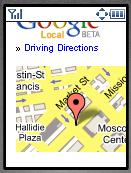
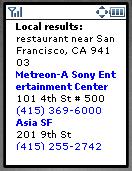
As it has for Yahoo, The last year has seen a flurry of mobile releases from Google. Late in 2004, Google introduced both an SMS Search and an updated WAP2 version of it’s mobile search. The new Mobile Search initially consisted only of web and image search, with no search for mobile sites! That omission was fixed in June of this year when an option to search the mobile web was added.
Also in 2005, Google unveiled a mobile Local Search (beta). for both WAP1 and WAP2. Unlike Yahoo, Google can find restaurants even if they don’t have “restaurant” in their name. In it’s Wap2 guise Google Local provides a 120 x120 map and driving directions. The WAP version offers neither – but phone numbers in the WAP1 results are WTAI enabled so you can call the establishment directly from WAP page.
Blogger Mobile which lets you post photos and items to your Blogger hosted blog via MMS was launched in May. An interesting feature is that you can create a blog directly from your phone, even if you don’t have Google ID. You have to enter your phone number, Google SMS’s you a passkey which you enter to access your blog.
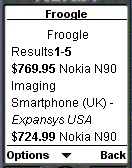
Froogle Mobile, a beta release which came out in August, is almost identical to Yahoo Mobile Shopping, being a simple price comparison tool. Interestingly, for 2005, Google choose to built Froogle Mobile as a WAP1 site. WAP1 actually isn’t a bad idea for a text-only site like Froogle. Virtually every WAP2 device also supports WAP1 so one site can support almost every web enabled phone.
Google’s latest mobile launch was of their vastly improved WAP2 Mobile Transcoding Engine which was included Wap Review’s four part comparison of mobile transcoding sites. here. Built into Mobile Web Search, the transcoder reformats desktop sites as xhtml-mp mobile sites. Web forms, but not secure forms, work as expected and most of the site’s original formatting is preserved. A unique feature of Google’s transcoder is that it collapses long menus to increase usability on small screen devices. The collapsed menu is represented by a plus sign which expands the menu when selected.
Google obviously believes in mobile’s future with no less than six new or enhanced mobile services released in the last 12 months. The quality of these new offerings is consistently high although I would like to see them do something a little more ambitious with Froogle Mobile.
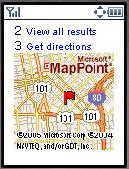
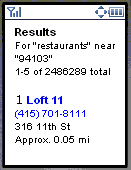
Microsoft launched their MSN WAP portal in May 2000. It included Hotmail, Address Book, News, Sports, Weather, Yellow Pages search, driving directions, flight information and access to stock quotes from your MSN Money web portfolio and to Expedia travel itineraries. Mobile MSN Messenger was added in 2002 initially as an exclusive offering for Verizon Wireless customers.
This year Microsoft got serious about the mobile web again. In March, 2005 WindowsMedia,com Mobile which features music video and movie trailer downloads in Microsoft’s proprietary format – currently only supported by Windows Mobile devices although Nokia promises support in upcoming phones.
Local Search (beta) which is very similar to the Google and Yahoo Local Search offerings came out in June. Searches by keyword and zip code or address return a list of hits, selecting a hit gives a map and a link to driving directions. The quality of the local search seems good, finding most of the restaurants in my neighborhood, for example. Browser detection is used to vary the map’s size from 110 x 110 to 217 x 217 px depending on phone capabilities.
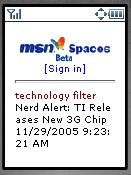
August 2005 saw the release of MSN Spaces Mobile (beta) which allows you to create a MSN Spaces blog directly from your WAP2 enabled phone. You can also post to your blog. Spaces is a somewhat usual combination of bloging and social networking. You can only view the blogs of members who have invited you or who are in your Hotmail address book. Except that everyone can read the five most recently updated blogs at any given point in time! There are also four Microsoft news feeds (Lifestyle, Sports, Music and Technology) that everyone can read and leave comments about.
Microsoft recently announced an invitation-only beta of Mobile Web Search. MS’s version appears from the descriptions to be a web search plus transcoding mashup similar to Google’s. I’m looking forward to seeing it.
Microsoft is also clearly interested in a mobile future with four new mobile products released or announced since March.
| Yahoo | Microsoft | ||
| WAP2 | X | X | X |
| Local Search | X | X | X |
| SMS Search | X | X | |
| Image Search | X | X | |
| Shopping | X | X | |
| Blog Posting | X | X | |
| Web Search | X | X | |
| Transcoding | X | X | |
| Photos | X | ||
| RSS Reader | X | ||
| Video | X |
So what can we learn from the mobile strategies of the big three? Clearly, Yahoo, Google and Microsoft are making a sizable investment in mobile web enhancements. They are also obviously watching each other judging by the similarity of their offerings.
The adoption of WAP2 for new projects is hardly a surprise. The newer markup is finally being supported by most new phone releases. It adds so much to the browsing experience, particularly by enabling the use of color text, backgrounds and images plus CSS styles and controls like radio buttons and checkboxes – all of which are missing from WAP1. I think we will see very few new projects with WAP1 support even though WAP1-only devices are still relatively common. The reality is that new projects get built with new technology. But if I was building a new mobile web site, I would support both WAP1 and WAP2 to increase my potential market. Tools like the Open Source WALL make it quite easy to built a multi-serving (WAP1, WAP2, i-Mode) site.
Local Search is a good fit for mobile – when I’m out and about and want to find a restaurant, store or movie – I expect to be able to find it using the mobile web. I’m sure some of the enthusiasm for local is in anticipation of the carriers eventually unshackling the location features in modern phones. If your phone knew your location, you could have a page that constantly showed you close by restaurants, theater, shops, etc. Now that would be a killer mobile app.
SMS Search, makes sense in the short term as users still seem more comfortable with SMS than with WAP. It will become less important as cheap unlimited data plans become the norm and mobile browsers and sites achieve the maturity to provide a richer, more user friendly experience.
Image Search I think was kinda a no-brainer for these companies which already have massive databases of images. I’m not sure how popular searching for images on one’s phone is, but if I had a phone that could save browser images as wallpapers I’d use it allot.
Mobile shopping sites are another area with growth potential. Currently, mobile shopping is held back because of difficulties in managing payments and SSL across multiple carriers. Anyone who can come up with a truly universal mobile payment solution will make a bundle. In the short term, how about a shopping/price comparison mobile site that lets you purchase by making a phone call directly from the search results?
Blogs and Blogging are hot, and mobloging was a big buzzword a year ago, so it is natural that the big three would want to have a presence in this area. I think that there is still an unmet need for a really good mobile web based RSS reader as well as WAP based blog posting and blog search tools.
A Search engine that can search the “big” web and transcode it into something useful on a small mobile screen seems like an enormously attractive idea. We have seem numerous attempts to do this recently. Wap Review’s four part comparison of Mobile Transcoding Sites covers most of them. Some of these transcoding sites do a fairly good job but I feel that we have just scratched the surface of what can be done with transcoding technology.
Sites like Yahoo’s for managing your camera phone photos can be useful but they have to complete with the carrier’s own photo portals. I don’t see this as much of a growth area anymore.
Video is currently generating major mobile buzz. With 3G, mobile video presents exceptional opportunities. Microsoft has a foot in the door here but their mobile web videos are mostly only playable on Windows Mobile devices. There is definitely room for more innovative video sites like RocketBoom Mobile.
Thanks for the comment Alexia. I’ll take your word and that of Russell Beattie that Yahoo does do transcoding, however it seems to be very picky about what phones and possibly which carriers it will serve transcoded content to.
My tests were done by modifying the user-agent header sent by the Netfront and Nokia WAP emulators to simulate various phones. For all the mainstream xhtml-mp capable phones (Nokia 6101 and 3650, Motorola RAZR and V180 and LG 225) that I tried, Yahoo would return only WML! The only way I could even get xhtml-mp pages was If I used the UA of a Windows Mobile or Palm OS phone. Using the Windows and Palm UA’s the results of web searches were NOT transcoded.
According to Russ’ own comment,
That’s just plain silly, what the heck does which carrier I’m using have to do with my need or desire to view transcoded Wap pages?
You have incorrectly stated that Yahoo does not offer transcoding. Yahoo Mobile does provide transcoding on search results in the Web Search. This is the description given in Yahoo Search Blog (written by Russell Beattie):-
“We’re also aware that most people who do have phones that can access the Internet, don’t have full HTML browsers yet, so many pages that come back from general search results have only been accessible to more advanced PDA-like phones like Palm Treos that can display full-on web pages. We’ve now finally fixed that hole in our mobile offerings by providing a transcoding process on the search results for all WAP2 enabled phones. In other words, once you’ve done a search and click on one of the resulting links, if you’re using a phone with a WAP2 browser, we’ll translate the web page for you so it’s accessible on your handset. But we leave some of the images in and not cut the page up too badly – in other words, it be both accessible and usable at the same time. We are also using shortcuts in this service, something that sets us apart from the competition.”
In your comparison table, one additional thing that’s worth mentioning is that MSN enables the full blogging experience via it’s mobile site. You can not only create and post to blogs, but you can view blog entries, photos in blogs, comments or post your own comments.
We also recently launched Windows Live Search and Windows Live Mail for mobile devices. Check out mobile.live.com
Thanks for the comment, Bob.
4Info is good, I did a mini review on them in the Search section of the Wap Directory. The thing that the big three and AOL have is placement in the carriers portals. I saw a metric somewhere that claimed that 80% of US mobile web users never go beyond the sites on their carrier’s portal. To succeed, 4Info may need to get into those Portals. I’ll check out upsnap, thats a new name to me.
Randell, Mobot, Neomedia and Shelron are also names I need to Google or Yahoo!
What are your thoughts on niche players, like 4info.net and upsnap taking the reigns on mobile search? Would love to see you guys do a review on 4info. Seems that every time I read something about mobile search, the journalist is commenting on how 4info kicks tail.
Regarding the Microsoft gaps to Yahoo and Google. Allow me to suggest RE: Vista – Everything in position 1) For the alternative to SMS – look to Neomedia and their patents. 2) Image Search – look to ‘Mobot’ (Neomedia). 3) Shopping – look to Shelron (Neomedia affiliate). In summation look in many ways for the “GAP” to be MORE than filled! Randell